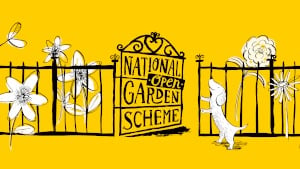About Feeringbury Manor
The garden of Feeringbury Manor is on an ancient site. The land originally belonged to William the Conqueror and parts of the house date back to before 1500. We moved here in 1978 and immediately set to work, clearing brambles and nettles. planting hedges and trees and digging beds. On entering the garden the first thing you will see, is a long bed, backed by an unusual trellis made by Ben Coode-Adams. This bed is a blend of mixed planting of shrubs, roses and herbaceous plants. On the left looking its best from February to April we have planted a circular “jewelled lawn” of tiny bulbs, nothing over 20ins. At various times there are dwarf tulips, tiny narcissi and the blue of grape hyacinths or chionodoxa. Anemone pavonina is very slowly beginning to colonise the bank.
Under the huge old yew tree to the left of the house you enter the main garden. Here there is a plethora of different plants and shrubs, with something flowering throughout the year. This is the main garden area and it is filled with interesting shrubs from a poncirus to hoheria. There is always plenty of colour as the year progresses. We grow many interesting annuals, perennials, shrubs and and are gradually establishing more roses growing into trees. The principle of the garden is that we like to see masses of different plants, so that you really have to study the planting to find the surprises such as epimediums, interesting violas and thalictrums. This does not mean that there are not clumps of colour, such as crocosmias, large quantities of different day lilies and a particular favourite, michaelmas daisies. There are two ponds, one some feet below the other. The top pond has a selection of damp loving plants growing around it, including irises and primulas. Hydrangeas are beginning to establish themselves for later colour.
There is a stream falling from the pond over a Victorian waterwheel into the lower pond, which then leads through a pretty stream bed to the river Blackwater. In the lower part of the garden, beside the river, is a small arboretum with a collection of euonymus, sorbus and crab apples, spectacular in the Autumn. The numerous berried trees and shrubs and autumn colour give the garden added interest particularly in late September. The whole garden is pulled together by various gates, arbours and benches made in galvanised steel by Ben Coode-Adams, the sculptor. He mainly undertakes public commissions and has work all over Britain from Chadkirk chapel in the North to Melton Mowbray, to London where he has many public works.
Our aim in the garden is to have a strong structure to the garden, with yew and box hedges and some walls, within which is a joyous blossoming ebullience and always something interesting to see.

.jpg)
.jpg)
.jpg)
.jpg)
.jpg)
.jpg)
.jpg)
.jpg)
.jpg)
.jpg)
.jpg)
.jpg)
.jpg)
.jpg)
.jpg)
.jpg)



.jpg)
.jpg)
.jpg)
.jpg)
.jpg)